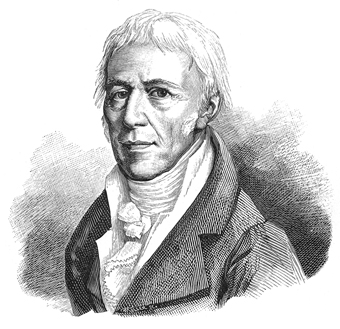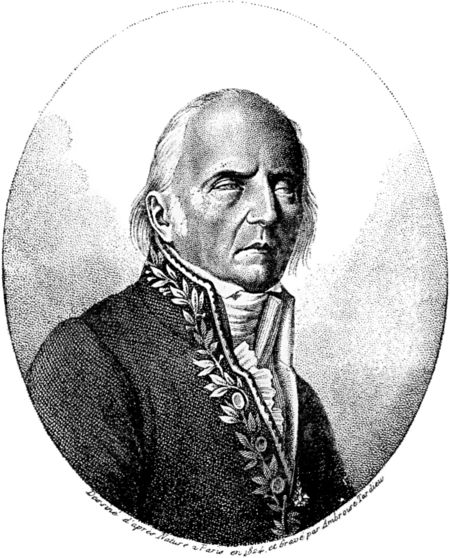<Back to Index>
- Naturalist Jean-Baptiste Pierre Antoine de Monet, Chevalier de la Marck, 1744
- Novelist Herman Melville, 1819
- Prime Minister of Serbia Zoran Đinđić, 1952


Jean-Baptiste Pierre Antoine de Monet, Chevalier de la Marck (1 August 1744, Bazentin, Somme – 18 December 1829), often just known as "Lamarck", was a French soldier, naturalist, academic and an early proponent of the idea that evolution occurred and proceeded in accordance with natural laws.
Lamarck fought in the Pomeranian War with Prussia, and was awarded a commission for bravery on the battlefield. At his post in Monaco, Lamarck became interested in natural history and resolved to study medicine. He retired from the army after being injured in 1766, and he returned to his medical studies. Lamarck developed a particular interest in botany, and later, after he published a three-volume work Flora française, he gained membership of the French Academy of Sciences in 1779. Lamarck became involved in the Jardin des Plantes and was appointed to the Chair of Botany in 1788. When the Muséum national d'Histoire naturelle was founded in 1793, Lamarck was appointed as a professor of zoology. In 1801, he published Système des animaux sans vertèbres, a major work on the classifications of invertebrates, a term he invented. In an 1802 publication, he became one of the first to use the term biology in its modern sense. Lamarck continued his work as a premier authority on invertebrate zoology. In the modern era, Lamarck is remembered primarily for a theory of inheritance of acquired characters, called soft inheritance or Lamarckism. However, his idea of soft inheritance was, perhaps, a reflection of the folk wisdom of the time, accepted by many natural historians. Lamarck's contribution to evolutionary theory consisted of the first truly cohesive theory of evolution, in which an alchemical complexifying force drove organisms up a ladder of complexity, and a second environmental force adapted them to local environments through use and disuse of characteristics, differentiating them from other organisms.
Lamarck was born in Bazentin, Picardie, northern France, as the eleventh child in an impoverished aristocratic family. Male
members of the Lamarck family had traditionally served in the French
army. Lamarck's eldest brother was killed in combat at the Siege of Bergen-op-Zoom,
and two other brothers were still in service when Lamarck was in his
teenage years. Yielding to the wishes of his father, Lamarck enrolled
in a Jesuit college in Amiens in the late 1750s. After
his father died in 1760, Lamarck bought himself a horse, and rode
across the country to join the French army, which was in Germany at the
time. Lamarck showed great physical courage on the battlefield in the Pomeranian War with Prussia, and he was even nominated for the lieutenancy. Lamarck's
company was left exposed to the direct artillery fire of their enemies,
and was quickly reduced to just fourteen men - with no officers. One of
the men suggested that the puny, seventeen year-old volunteer should
assume command and order a withdrawal from the field; but although
Lamarck accepted command, he insisted they remain where they had been
posted until relieved. When their colonel reached the remains of their
company, this display of courage and loyalty impressed him so much that
Lamarck was promoted to officer on the spot. However, when one of his
comrades playfully lifted him by the head, he sustained an inflammation
in the lymphatic glands of the neck, and he was sent to Paris to
receive treatment. He underwent a complicated operation, and continued his treatment for a year. He was awarded a commission and settled at his post in Monaco. It was there that he encountered Traité des plantes usuelles, a botany book by James Francis Chomel. With
a reduced pension of only 400 francs a year, Lamarck resolved to pursue
a profession. He attempted to study medicine, and supported himself by
working in a bank office. Lamarck
studied medicine for four years, but gave it up under his elder
brother's persuasion. He was interested in botany, especially after his
visits to the Jardin du Roi, and he became a student under Bernard de Jussieu, a notable French naturalist. Under
Jussieu, Lamarck spent ten years studying French flora. After his
studies, in 1778, he published some of his observations and results in
a three-volume work, entitled Flora française.
Lamarck's work was respected by many scholars, and it launched him into
prominence in French science. On August 8, 1778, Lamarck married Marie
Anne Rosalie Delaporte. Georges-Louis Leclerc, Comte de Buffon, one of the top French scientists of the day, mentored Lamarck, and helped him gain membership to the French Academy of Sciences in 1779 and a commission as a Royal Botanist in 1781, in which he traveled to foreign botanical gardens and museums. Lamarck's first son, André, was born on April 22, 1781, and he made colleague André Thouin the child's godfather. In
his two years of travel, Lamarck collected rare plants that were not
available in the Royal Garden, and also other objects of natural
history, such as minerals and ores, that were not found in French
museums. On January 7, 1786, his second son, Antoine, was born, and
Lamarck chose Antoine Laurent de Jussieu, Bernard de Jussieu's nephew, as the boy's godfather. On April 21 of the following year, Charles Rene, Lamarck's third son, was born. René Louiche Desfontaines,
a professor of botany at the Royal Garden, was the boy's godfather,
and Lamarck's elder sister, Marie Charlotte Pelagie De Monet was the
godmother. In 1788, Buffon's successor at the position of Intendant of the Royal Garden, Charles-Claude Flahaut de la Billaderie, comte d'Angiviller, created a position for Lamarck, with a yearly salary of 1,000 francs, as the keeper of the herbarium of the Royal Garden. In 1790, at the height of the French Revolution, Lamarck changed the name of the Royal Garden from Jardin du Roi to Jardin des Plantes, a name that did not imply such a close association with King Louis XVI. Lamarck had worked as the keeper of the herbarium for five years before he was appointed curator and professor of invertebrate zoology at the Muséum national d'histoire naturelle in 1793. During
his time at the herbarium, Lamarck's wife gave birth to three more
children before dying on September 27, 1792. With the official title of
"Professeur d’Histoire naturelle des Insectes et des Vers", Lamarck
received a salary of nearly 2,500 francs per year. The following year on October 9, he married Charlotte Reverdy, who was thirty years his junior. On
September 26, 1794, Lamarck was appointed to serve as secretary of the
assembly of professors for the museum for a period of one year. In
1797, his second wife Charlotte died, and he married Julie Mallet the
following year; she died in 1819. In
his first six years as professor, Lamarck published only one paper, in
1798, on the influence of the moon on the Earth's atmosphere. Lamarck began as an essentialist who believed species were unchanging; however, after working on themolluscs of the Paris Basin, he grew convinced that transmutation or
change in the nature of a species occurred over time. He set out to
develop an explanation, and on 11 May 1800 (the 21st day of Floreal, Year VIII, in the revolutionary timescale used in France at the time), he presented a lecture at the Muséum national d'histoire naturelle in which he first outlined his newly developing ideas about evolution. In 1801, he published Système des Animaux sans Vertebres,
a major work on the classification of invertebrates. In the work, he
introduced definitions of natural groups among invertebrates. He
categorized echinoderms, arachnids, crustaceans and annelids, which he separated from the old taxon for worms known as Vermes. Lamarck was the first to separate arachnids from insects in classification, and he moved crustaceans into a separate class from insects. In 1802 Lamarck published Hydrogéologie, and became one of the first to use the term biology in its modern sense. In Hydrogéologie, Lamarck advocated a steady-state geology based on a strict uniformitarianism.
He argued that global currents tended to flow from east to west, and
continents eroded on their eastern borders, with the material carried
across to be deposited on the western borders. Thus, the Earth's
continents marched steadily westward around the globe. That year, he also published Recherches sur l'Organisation des Corps Vivants,
in which he drew out his theory on evolution. He believed that all life
was organized in a vertical chain, with gradation between the lowest
forms and the highest forms of life, thus demonstrating a path to
progressive developments in nature. During Lamarck's lifetime he became controversial, attacking the chemistry proposed by Lavoisier.
In his own work, Lamarck had favored a traditional theory based on four
elements. He also came into conflict with the widely respected palaeontologist Georges Cuvier,
who was not a supporter of evolution. According to Bowler, "[Cuvier]
ridiculed Lamarck's theory of transformation and defended the fixity of
species." Lamarck gradually turned blind and died in Paris on
December 18, 1829. When he died, his family was so poor they had to
apply to the Academie for financial assistance. Lamarck's books and the
contents of his home were sold at auction, and his body was buried in a
temporary lime-pit. After his death, Cuvier used the forum of a eulogy to denigrate Lamarck.